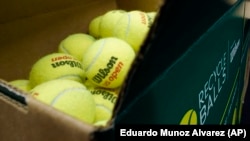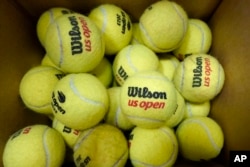The sport of tennis has a problem with waste that many players do not even recognize each time they open a new container of game balls.
The balls are not recyclable. Almost all of the 330 million balls manufactured each year end up in waste, or garbage, landfills. Once there, it can take as long as 400 years for the balls to decompose. Major professional tennis competitions go through nearly 100,000 balls during two weeks of play.
The problem of tennis ball waste has sent ball makers, tennis officials, and recycling companies looking for solutions.
Nickolas J. Themelis is director of Columbia University’s Earth Engineering Center.
“Tennis balls, like a lot of objects, are made to be indestructible, which means they’re very resistant to mechanical processing,” he said.
“But do you take a useful object that lasts forever and say people shouldn’t use it because it lasts forever? That’s nonsense,” he added.
Themelis and other experts note that tennis balls make up a tiny percentage of the hundreds of millions of metric tons of garbage produced every year. He says part of the solution is finding ways to do other things with the balls.
“Anyone who would say you shouldn’t play tennis because of the tennis balls is misinformed,” said Jason Quinn, director of Colorado State University’s Sustainability Research Laboratory. He added, “There are things you can do to reuse and repurpose tennis balls to lessen the impact.”
Individual used balls sometimes become playthings for dogs or are re-used in other small ways. But, huge numbers of used balls can also be crushed to pieces for use as building material, like flooring.
Tennis ball materials
However, experts and environmental groups say that still does not solve the problem of tennis ball recycling. The balls’ outer soft layer, called the felt, is strongly attached to a soft center. The felt is a combination of wool and nylon which cannot be recycled.
In addition, the center of top-level balls are made with rubber from rubber trees. Environmental groups say this leads to deforestation in the Amazon.
Jason Collins is chief of international racquet sports for Wilson Sporting Goods company. He said that its top-level balls use rubber directly from the trees. However, he said Wilson also makes other tennis balls that include recycled rubber material.
Working on the problem
The International Tennis Federation (ITF) is a governing body of professional tennis. Last year the ITF brought together manufacturers, tennis officials and recyclers to begin working on the tennis ball issue. The group is working to find answers to questions such as: Is there a way to design a fully recyclable ball? Can the ITF change rules so balls are used longer in play? How well do various kinds of balls perform at different levels of play?
Currently, professional players change to a new set of balls after the first seven games and then after every nine games.
Jamie Capel-Davies is the head of science and tech at ITF. He said there are four levels in the effort to reduce the waste.
“First of all, to try and reduce the number of balls that are being used. Then reuse balls as best we can. Recycling is third,” he said.
The fourth level is disposal, meaning placing the balls in landfills. Most balls are disposed into landfills.
Manufacturers and recyclers have begun taking steps to reduce and reuse balls.
Wilson Sporting Goods introduced its Triniti ball that keeps air inside the core longer and has a stronger felt.
Vermont-based RecycleBalls says it expects to collect 3 million tennis balls this year from across the U.S and Canada.
“We believe in multiple lives for tennis balls,” said RecycleBalls leader Erin Cunningham. But, the group does not want the used balls to stay forever in their storage center.
“We need to make sure that there’s actually demand for recycled product on the back end,” Cunningham said.
Columbia University’s Themelis believes the final resting place of tennis balls should not be landfills but waste-to-energy plants that burn garbage to generate electricity.
However, opponents of the idea say burning the balls to create electricity also adds to air pollution. They say there are better and cleaner new uses.
I’m Andrew Smith. And I'm Gena Bennett.
James Martinez wrote this story for The Associated Press. Andrew Smith adapted it for VOA Learning English.
_________________________________________________
Words in This Story
recycle -v. to process material, such as paper, glass, or plastic, in order to use it again
decompose -v. to chemically break down
layer -n. a piece of material that covers a surface or is between two other things
racquet -n. an oval shaped bat with strings across it, used to hit balls in sports such as tennis, squash and badminton
actually -adv. true in fact; in reality










Forum